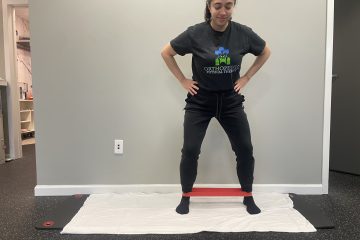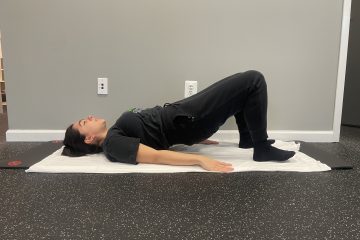 Picture this: you’re walking into your house, key in the door, and all of sudden you get that urge to pee. RIGHT NOW. It’s an EMERGENCY, and if you don’t go right this second, you’re absolutely going to pee your pants.
Picture this: you’re walking into your house, key in the door, and all of sudden you get that urge to pee. RIGHT NOW. It’s an EMERGENCY, and if you don’t go right this second, you’re absolutely going to pee your pants.
In the medical world, we call this urinary urgency and if leakage occurs from that strong sensation, then it is classified as urge urinary incontinence (UUI). This is different from the more commonly recognized stress urinary incontinence (SUI), which occurs with coughing, sneezing, laughing, or other physical activity. Though it has less name recognition, urge incontinence can be equally as frustrating and embarrassing.
We often see urge incontinence in combination with overactive bladder, which is classified as going to the bathroom more frequently than every two hours or more than eight times in a 24-hour period.
What is happening in the bladder when you experience urgency and leakage?
Urge incontinence happens when the urge to pee is greater than what the pelvic floor can withstand. In order to understand what occurs to make that happen, let’s take a crash-course on how the bladder and the brain work together.
The feeling of having to pee happens as the bladder fills. In a normal functioning bladder and pelvic floor, as the bladder fills, the pelvic floor tightens up so urine doesn’t “fall out.” Tightening in the pelvic floor and stretching of the bladder as it fills triggers signals to be sent from the brain to the bladder. The first signal of urgency is sent to the brain when the bladder is about 50% full. Most people recognize but can ignore this first signal. A second signal is then sent from the bladder to the brain when the bladder is about 75% full and that signal intensifies as the bladder continues to fill.
With overactive bladder and urge incontinence though, the bladder can get confused and start sending false signals to the brain. Things may seem more intense or urgent than they really are, which triggers the detrusor muscle (the muscle that pushes the urine out) to start firing before you’ve made it to the bathroom. If the pelvic floor can’t withstand the pressure from the bladder, you leak!
What causes urge incontinence and overactive bladder to develop?
Urgency, overactive bladder, and urge incontinence are influenced by a variety of factors related to the bladder and pelvic floor. The most common reasons this occurs includes:
- Bladder irritants–most commonly caffeine, carbonated beverages, alcohol, citrus products, and spicy foods
- Not drinking enough plain water–ideally, we want a minimum of half your body weight in ounces of plain water per day
- Going to the bathroom more frequently–the bladder can actually be trained to need to go more often, which leads to the urgency signals being sent earlier than in a normal functioning bladder
- Tension in the abdomen, pelvic floor, hips and/or back–this puts additional pressure on the bladder, which causes the bladder to send urgency signals earlier than if the bladder had more room
- Weakness is the core, hips, glutes, or pelvic floor–weakness in these areas can contribute to increased tightness in the pelvic floor, which puts more pressure on the bladder as it fills
“How can pelvic floor PT help me stop leaking and get my bladder under control?”
One of the best things you can do to address overactive bladder and urge incontinence is to work with a pelvic health physical therapist. In fact, it’s the only treatment that receives an “A” grading for evidence and effectiveness according to the American Urological Association. In pelvic floor PT we use a combination of behavioral strategies, manual techniques, lengthening, and strengthening to retrain the bladder and pelvic floor.
Behavioral strategies that your pelvic PT may implement in your treatment include:
- Discussing your bladder irritants and plain water intake and giving recommendations for limits or minimums
- Bladder retraining, which includes using bladder logs, timed voiding, urge suppression strategies, and downtraining to get you voiding within normal intervals (every 2-4 hours)
- Learning how to manage anxiety and bladder triggers and referring to mental health therapy as necessary
- Nervous system downregulation, i.e, relaxation strategies
Other pelvic PT strategies used to reduce overactive bladder and urge incontinence may include:
- Using manual techniques to lengthen and stretch the pelvic floor, abdominals, low back, inner thighs, glutes, and hips
- Mobility work for the pelvis, mid/low back, and hips
- Decompressing the bladder using bladder mobilizations, bladder scooping, and cupping
- Strengthening the hips, glutes, back, and core to allow the pelvic floor to be more dynamic and take pressure off the bladder
Outside of pelvic health physical therapy, your doctor may recommend seeking additional care and treatments to compliment your pelvic health care. For the treatment of overactive bladder and urge incontinence, you may also try suppositories, oral medications, nerve blocks, trigger point muscle injections, cognitive behavioral therapy, or yoga. Surgery and botox injections are not recommended as first line treatments in the management of overactive bladder or urge incontinence.
Remember, for many pelvic health conditions, it takes a holistic, multifaceted approach that involves treating YOU as a human being, rather than just the dysfunction of your muscles. The same goes for urge incontinence and overactive bladder.
Curious to learn a little bit more about how to get your bladder under control and stop peeing when you get that strong urge? Schedule your FREE 10-minute consult call today ✨
Be empowered in education,
OrthoPelvic Physical Therapy


